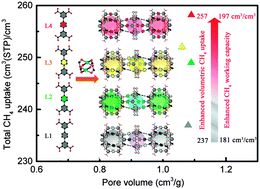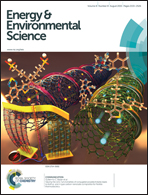Porous metal–organic frameworks with Lewis basic nitrogen sites for high-capacity methane storage†
Abstract
The use of porous materials to store/deliver natural gas (mostly methane) in vehicles requires large amounts of methane being stored per unit volume. In this work, we report several porous metal–organic frameworks (MOFs) with NOTT-101 type structures, containing Lewis basic nitrogen sites through the incorporation of pyridine, pyridazine, and pyrimidine groups into the organic linkers. They exhibit significantly higher total volumetric methane storage capacities (∼249–257 cm3 (STP) cm−3 at room temperature (RT) and 65 bar) than NOTT-101a (here the MOF abbreviation with “a” at the end represents the fully activated MOF). The most significant enhancement was observed on UTSA-76a with functional pyrimidine groups (237 cm3 (STP) cm−3 in NOTT-101a vs. 257 cm3 (STP) cm−3 in UTSA-76a). Several multivariate (MTV) MOFs constructed from two types of organic linkers (pyrimidine-functionalized and unfunctionalized) also show systematically improved methane storage capacities with increasing percentage of functionalized organic linkers. The immobilized functional groups have nearly no effect on the methane uptakes at 5 bar but significantly improve the methane storage capacities at 65 bar, so the reported MOFs exhibit excellent methane storage working capacities of ∼188–197 cm3 (STP) cm−3.


 Please wait while we load your content...
Please wait while we load your content...